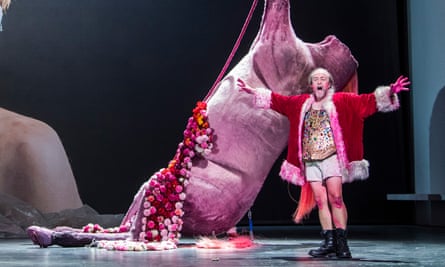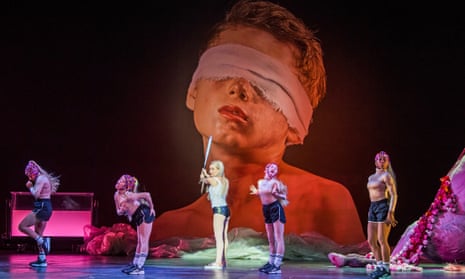Operatic history is dominated by male narratives of female sexuality, none of them more confrontational, perhaps, than Strauss’s Salome, in which transgressive love turns fatally obsessive and can only find eventual consummation in necrophilia. To open a season that promises, to quote artistic director Daniel Kramer, an exploration of “the patriarchal structures, relationships and roles of masculinity within our society”, English National Opera is presenting a new staging by the Australian director Adena Jacobs, whose work is rooted in reimagining the classics from a radical, contemporary and feminine perspective. Jacobs’ thesis – and few would disagree – is that Salome can only express and fulfil her desires in terms of the objectifying male constructs with which she has been brought up. Whether Jacobs adequately realises her concept is a different matter.
Her staging sets it out wonderfully well. Armed men stand beneath a tank, in which a naked body floats – whether it is male or female is unclear. Our instinctive desire is to ascertain the figure’s gender, which is Jacobs’ cue to draw us into voyeuristic complicity with what immediately follows. Allison Cook’s androgynous Salome emerges, pale and nervous, from behind the soldiers as Stuart Jackson’s Narraboth nervously twists an ominously bloodied handkerchief between his fingers. The subsequent encounter with David Soar’s Jokanaan is riddled with tension. A camera attached to a muzzle placed over Soar’s face projects an image of his mouth on to the backcloth, which turns from black-and-white to colour as Salome’s fascination grows. Cook’s explicit expressions of desire render her alarmingly vulnerable, but Narraboth transforms them into pornography by filming her every move.
When Michael Colvin’s neurotic Herod and Susan Bickley’s haggard Herodias arrive, however, the tension evaporates and the production founders into a stream of hallucinatory images that disrupt narrative continuity and dramatic focus. The images can be both unsettling and banal, though they fail to cohere into a meaningful whole. Colvin slips and slithers in Narraboth’s blood, which the Jews have unavailingly tried to wash from the floor. A decapitated pink pony is strung up, its entrails turning into flowers as they spill from its body (blood and flowers soon become interchangeable in ways reminiscent of the works of Jean Genet).

The dance, in which Cook laconically strikes a series of provocative poses while four dancers gyrate round her, is genuinely chilling, though Jacobs never re-establishes the tension of the opening scenes in the escalation into nightmare that follows, and the ending is curiously anticlimactic.
Cook is a mezzo rather than the more usual soprano, which means she compensates for the lack of a genuine high pianissimo with some unsettling phases in those dark lower registers to which Strauss makes his heroine frequently descend. But she’s a fine vocal actor, immersing herself in the role with admirable commitment and abandon. Jokanaan lies high for Soar, and his voice is overamplified when he’s singing in his underground prison, though Colvin and Bickley are superb. She wonderfully suggests Herodias’s fraying dignity. He sounds all the more sinister for singing so elegantly and refusing to shout, like so many Herods. Martyn Brabbins conducts with great intensity, his interpretation gathering strength as it goes. The ENO Orchestra play outstandingly for him, with every shift in colour beautifully realised.
At the Coliseum, London, until 23 October.

Comments (…)
Sign in or create your Guardian account to join the discussion